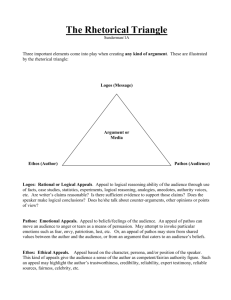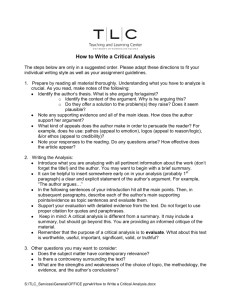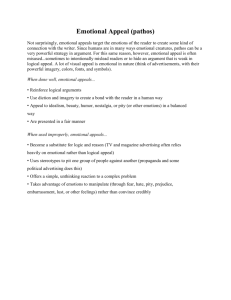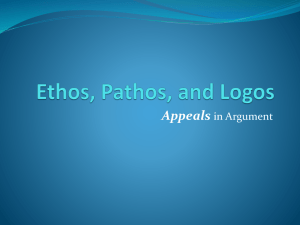Rhetorical Analysis of Magazine Ads
advertisement
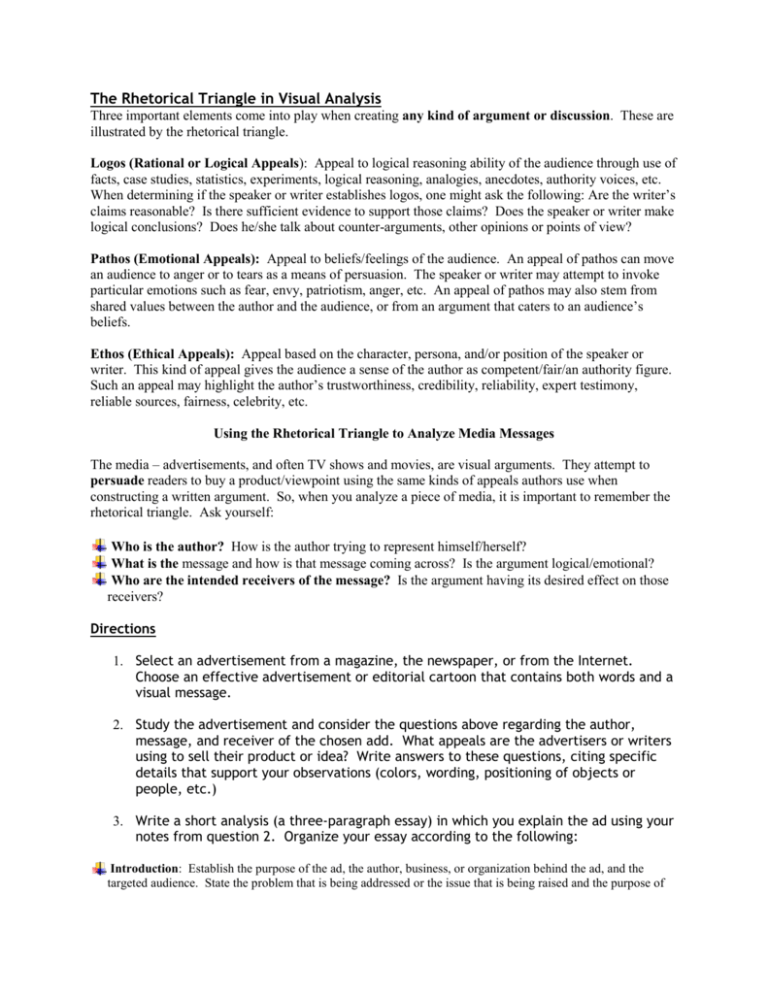
The Rhetorical Triangle in Visual Analysis Three important elements come into play when creating any kind of argument or discussion. These are illustrated by the rhetorical triangle. Logos (Rational or Logical Appeals): Appeal to logical reasoning ability of the audience through use of facts, case studies, statistics, experiments, logical reasoning, analogies, anecdotes, authority voices, etc. When determining if the speaker or writer establishes logos, one might ask the following: Are the writer’s claims reasonable? Is there sufficient evidence to support those claims? Does the speaker or writer make logical conclusions? Does he/she talk about counter-arguments, other opinions or points of view? Pathos (Emotional Appeals): Appeal to beliefs/feelings of the audience. An appeal of pathos can move an audience to anger or to tears as a means of persuasion. The speaker or writer may attempt to invoke particular emotions such as fear, envy, patriotism, anger, etc. An appeal of pathos may also stem from shared values between the author and the audience, or from an argument that caters to an audience’s beliefs. Ethos (Ethical Appeals): Appeal based on the character, persona, and/or position of the speaker or writer. This kind of appeal gives the audience a sense of the author as competent/fair/an authority figure. Such an appeal may highlight the author’s trustworthiness, credibility, reliability, expert testimony, reliable sources, fairness, celebrity, etc. Using the Rhetorical Triangle to Analyze Media Messages The media – advertisements, and often TV shows and movies, are visual arguments. They attempt to persuade readers to buy a product/viewpoint using the same kinds of appeals authors use when constructing a written argument. So, when you analyze a piece of media, it is important to remember the rhetorical triangle. Ask yourself: Who is the author? How is the author trying to represent himself/herself? What is the message and how is that message coming across? Is the argument logical/emotional? Who are the intended receivers of the message? Is the argument having its desired effect on those receivers? Directions 1. Select an advertisement from a magazine, the newspaper, or from the Internet. Choose an effective advertisement or editorial cartoon that contains both words and a visual message. 2. Study the advertisement and consider the questions above regarding the author, message, and receiver of the chosen add. What appeals are the advertisers or writers using to sell their product or idea? Write answers to these questions, citing specific details that support your observations (colors, wording, positioning of objects or people, etc.) 3. Write a short analysis (a three-paragraph essay) in which you explain the ad using your notes from question 2. Organize your essay according to the following: Introduction: Establish the purpose of the ad, the author, business, or organization behind the ad, and the targeted audience. State the problem that is being addressed or the issue that is being raised and the purpose of the heightened awareness (to persuade, to galvanize people to action, to inform, or to win one’s support). Body: Explain in more detail the extent to which each appeal is being used in the advertisement. Offer details to support your observation. Determine the claim of the advertisement and the assumptions the author makes about the audience in this ad. Discuss each appeal by citing evidence that supports your observations. Conclusion: Write an evaluation of the advertisement or editorial, stating the ad’s effectiveness in achieving its purpose with its targeted audience. If the desired message is effective, what is the outcome or consequences for the receiver or for society, in general? 4. Summarize your essay in a visual format. Log on to emaze.com and create a presentation (may be only one slide or multiple slides). Upload your ad (scan if in print) and add notations addressing the essay. Specific Questions to Consider: Focusing on the author, speaker, persona: ethical appeal (ethos) Who is the author? Is it a business firm trying to sell you a product or a service, a public organization seeking to inform you about its policies, a politician trying to win your allegiance, an interest group or media member trying to change your opinion about an issue? Other? What is the ethos (general credibility) of the author? What is the ad trying to accomplish? In other words, what is the sender’s “problem?” There is often some kind of communication problem behind an ad or campaign. For example, the authors may seek more awareness on the part of the receiver, or more legitimacy for themselves. Are you aware of any problems the sender (company) may be having within that specific industry, market, or area of activity? Focusing on the message or subject: logical appeal (logos) What is the simple message of the media? What product is the ad trying to sell? What is the subject of the movie/TV show? What is the true message of the media? Are there any hidden meanings the receiver is intended to observe? Do any connotations come to mind when you view the media? What ideologies or values does the piece of media invoke? In other words, what images, discourses, concepts, myths, etc. of the culture does the media use when making an appeal? How is the message presented? In an advertisement, what is the layout? What images, text appear, etc.? If it is a TV Show or movie, who are the characters? What is the setting, etc? How does the media connect concrete features with abstract values? In other words, how does the presentation of the message communicate deeper/abstract meanings (our values/norms) in addition to the simpler meaning (what is being sold)? Focusing on the audience or receiver: emotional appeal (pathos) Who is the targeted audience? What individuals/group of individuals is/are intended to receive the message? Is the media having the desired effect on the targeted audience? Are the logical/emotional/ethical appeals working? Is the audience being persuaded to buy what the media/advertisers are selling? If yes, why? If not, why not? If the desired message comes across effectively, might there be any consequences for the receivers? For society as a whole?


